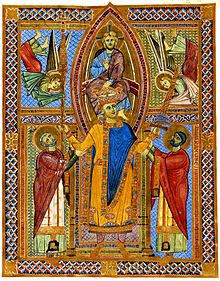| Henry II | |
|---|---|
| Emperor of the Romans | |
 Henry II as depicted in the Regensburg Sacramentary | |
| Holy Roman Emperor | |
| Reign | 14 February 1014 – 13 July 1024 |
| Coronation | 14 February 1014 Old St. Peter's Basilica, Rome |
| Predecessor | Otto III |
| Successor | Conrad II |
| King of Italy | |
| Reign | 15 May 1004 – 13 July 1024 |
| Coronation | 15 May 1004 Pavia, Kingdom of Italy |
| Predecessor | Otto III Arduin of Ivrea |
| Successor | Conrad II |
| King of Germany | |
| Reign | 7 June 1002 – 13 July 1024 |
| Coronation | 7 June 1002 Mainz, Kingdom of Germany |
| Predecessor | Otto III |
| Successor | Conrad II |
| Duke of Bavaria | |
| Reign | 28 August 995 – 21 March 1004 1009 – December 1017 |
| Predecessor | Henry II |
| Successor | Henry V |
| Born | 6 May 973 Abbach,[1] Bavaria, Germany, Holy Roman Empire |
| Died | 13 July 1024 (aged 51) near Göttingen, Germany, Holy Roman Empire |
| Burial | |
| Spouse | Cunigunde of Luxembourg |
| House | Ottonian |
| Father | Henry II, Duke of Bavaria |
| Mother | Gisela of Burgundy |
| Religion | Chalcedonian Christianity |
Henry II (German: Heinrich II; Italian: Enrico II; Latin: Henricus; 6 May 973 – 13 July 1024 AD), also known as Saint Henry, Obl. S. B.,[a] was Holy Roman Emperor ("Romanorum Imperator") from 1014. He died without an heir in 1024, and was the last ruler of the Ottonian line. As Duke of Bavaria, appointed in 995, Henry became King of the Romans ("Rex Romanorum") following the sudden death of his second cousin, Emperor Otto III in 1002, was made King of Italy ("Rex Italiae") in 1004, and crowned emperor by Pope Benedict VIII in 1014.
The son of Henry II, Duke of Bavaria, and his wife Gisela of Burgundy, Emperor Henry II was a great-grandson of German king Henry the Fowler and a member of the Bavarian branch of the Ottonian dynasty. Since his father had rebelled against two previous emperors, the younger Henry spent long periods of time in exile, where he turned to Christianity at an early age, first finding refuge with the Bishop of Freising and later during his education at the cathedral school in Hildesheim. He succeeded his father as Duke of Bavaria in 995 as "Henry IV". As duke, he attempted to join his second-cousin, Emperor Otto III, in suppressing a revolt against imperial rule in Italy in 1002. Before Henry II could arrive, however, Otto III died of fever, leaving no heir. After defeating several contenders to the throne, Henry II was crowned King of Germany on 9 July 1002 as the first in a line of kings to adopt the title Rex Romanorum as an antedate to his coronation in Rome as Imperator Romanorum.[2] On 15 May 1004, he was anointed King of Italy ("Rex Italiae"). In that same year, Henry II joined Duke Jaromír of Bohemia in his struggle against the Poles, thus effectively incorporating the Duchy of Bohemia into the Holy Roman Empire.[3]
Unlike his predecessor Otto III, who had imposed plans on sovereign administration and active political involvement in Italy, Henry spent most of his reign concerned with the renovation of the imperial territories north of the Alps, a policy summed up on his seal as Renovatio regni Francorum, which replaced Otto's Renovatio imperii Romanorum.[4] A series of conflicts with the Polish Duke Bolesław I, who had already conquered a number of countries surrounding him, required Henry II's full attention and years of political and military maneuvering. Henry did, however, lead three expeditions into Italy to enforce his feudal claim (Honor Imperii): twice to suppress secessionist revolts and once to address Byzantine attempts to obtain dominance over southern Italy. On 14 February 1014, Pope Benedict VIII crowned Henry Holy Roman Emperor in Rome.
The rule of Henry II has been characterized as a period of centralized authority throughout the Holy Roman Empire. He consolidated his power by cultivating personal and political ties with the Catholic Church. He greatly expanded the Ottonian dynasty's custom of employing clerics as counter-weights against secular nobles. Through donations to the Church and the establishment of new dioceses, Henry strengthened imperial rule across the Empire and increased control over ecclesiastical affairs. He stressed service to the Church and promoted monastic reform. For his remarkable personal piety and enthusiastic promotion of the Church, he was canonized by Pope Eugene III in 1146. He is the only medieval German monarch ever to have been honoured as a saint. Henry II's wife was the equally pious Empress Cunigunde, who was canonized in 1200 by Pope Innocent III.[5] As the union produced no children, the German nobles elected Conrad II, a great-great-grandson of Emperor Otto I, to succeed him after his death in 1024. Conrad was the first of the Salian dynasty of emperors.
- ^ Frank N. Magill (ed.), The Middle Ages: Dictionary of World Biography, Volume 2, Routledge, 2012, p. 449.
- ^ Bryce, James (1871). The Holy Roman Empire. p. 536.
- ^ Germany (1740). The Right of Succession to the Empire of Germany, hereditary and elective. the Booksellers. pp. 11–.
- ^ Blumenthal, Uta-Renate (1988). The Investiture Controversy: Church and Monarchy from the Ninth to the Twelfth Century. University of Pennsylvania Press. pp. 45–. ISBN 0-8122-1386-6.
- ^ Bernd Schneidemüller. "Heinrich II. und Kunigunde Das heilige Kaiserpaar des Mittelalters" (PDF). CORE. Retrieved 28 January 2020.
Cite error: There are <ref group=lower-alpha> tags or {{efn}} templates on this page, but the references will not show without a {{reflist|group=lower-alpha}} template or {{notelist}} template (see the help page).